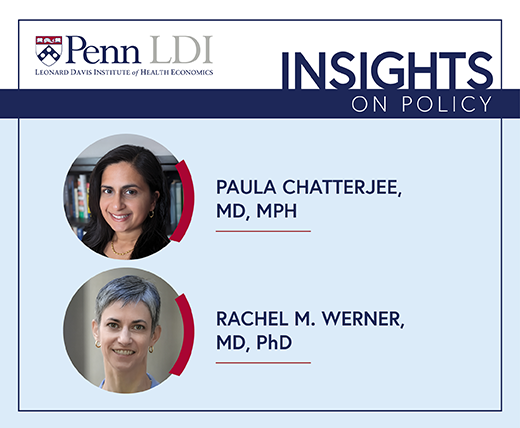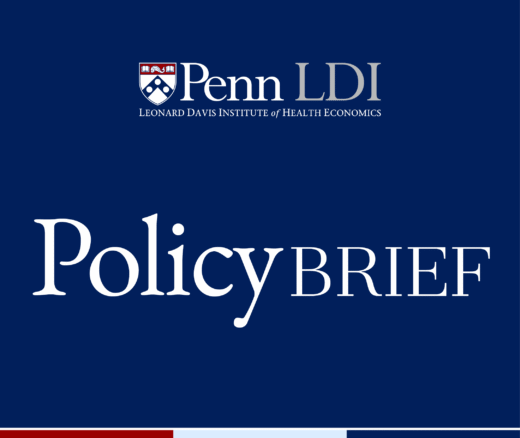
Nursing Home Incentive Program Falls Flat, New Work Explains Potential Reasons
A Major Federal Value-Based Purchasing Program Was Designed to Cut Hospital Readmissions. LDI Fellows Say the Incentives Are Too Small to Drive Real Change
News
Annually, Penn LDI provides small grant funding for early-stage investigations that would otherwise not qualify for larger NIH or other institutional grants. In 2025, 14 LDI Fellows have been awarded pilot grants for research projects across a range of topics involving the cost, access, quality, and equity of health care. Below are the researchers and their projects.
Principal Investigator: Diane Alexander, PhD | Wharton School
Co-Investigators: Benjamin Schwab and David Slusky

Our study will review the physician response to the legalization of medical marijuana using unique physician-level data on both marijuana certifications and traditional treatments. The project will be the first in-depth study on how physicians utilize marijuana in their practice, the characteristics that explain marijuana-prescribing behavior, and the extent to which the option to recommend medical marijuana influences substitution away from other pharmaceutical treatments, such as opioids. We will utilize a novel dataset of medical marijuana certifications signed by physicians in Connecticut from 2014-2019, combined with prescription and claims data for the patients of these physicians from the state of Connecticut’s All-Payer Claims Database. The resulting dataset will allow us to understand the non-marijuana treatment of physicians with different levels of medical marijuana engagement and allow us to study patient outcomes and how the availability of medical marijuana impacted physician treatment and prescribing decisions.
Principal Investigator: Heather Brom, PhD, RN | Penn School of Nursing
Co-Investigator: J. Margo Brooks Carthon, PhD, RN

Nearly 13 million individuals are dually insured by Medicare and Medicaid (“dual eligibles” or “duals”), accounting for nearly $500 billion in combined spending. Duals are younger, sicker, and more frequently hospitalized compared to Medicare-only enrollees. Compounding this, up to 80% of duals experience health-related social needs like transportation issues, social isolation, and housing insecurity. These challenges, along with the complexities of having two insurers, complicate their post-hospital discharge transitions. While integrated insurance plans are a long-term solution, they require complex, multi-level policy changes. Thrive, an evidence-based equity-focused transitional care model, offers an immediate alternative. Operating in three University of Pennsylvania Health System hospitals, Thrive provides wraparound services including home care, virtual case management, connections to community-based resources, and prolonged provider engagement. Our study will evaluate post-hospitalization outcomes and explore the experiences of care transitions among dually eligible Thrive participants, providing important evidence to refine Thrive’s model and support its adaptation and broader sustainment.
Principal Investigator: Joniqua Ceasar, MD | Perelman School of Medicine
Co-Investigators: Eugenia South, MD, MSHP and Sanya Curley

The summer of 2024 was the hottest on record, with Philadelphia enduring multiple heat emergencies. Low-income and Black communities, disproportionately affected by the urban heat island effect, often experience neighborhood temperatures up to 22°F higher than other areas. Extreme heat, the leading cause of weather-related deaths, drives significant morbidity and mortality by exacerbating chronic diseases and mental health disorders. Our study will evaluate the health benefits of the Low Income Home Energy Assistance Program (LIHEAP)-supported cooling assistance for energy-insecure households in Philadelphia—communities especially vulnerable to extreme heat. Partnering with a local nonprofit, we will assess health burdens and outcomes of LIHEAP recipients through cross-sectional surveys exploring baseline health and health care utilization, and findings will be compared to surveys completed by individuals on LIHEAP waitlists. By quantifying LIHEAP impacts, we hope our study will support program expansion and advocate for policies addressing heat exposure disparities—ensuring more equitable protection for vulnerable populations.
Principal Investigator: Lauren Eberly, MD, MPH | Perelman School of Medicine
Co-Investigators: Sharon Sandman, Denee Bex, Maricruz Merino, and Carmen George

For many American Indian patients, food insecurity is a major driver of cardiovascular health disparities. Our study will explore the intersection of food insecurity, cardiovascular health, pre-colonial food systems, and cultural connectedness. We plan to implement and evaluate a community-designed, culturally tailored culinary education program, which seeks to empower patients to prepare heart-healthy traditional Navajo meals using locally sourced ingredients. Through cooking classes led by a registered Navajo dietician, our study aims to improve clinical and behavioral outcomes, quality of life, and tribal connectedness. Designed in collaboration with tribal and community partners, this initiative will occur as part of a larger ongoing Food is Medicine clinical trial of medically-tailored traditional meals. We hope our findings will inform future Food is Medicine policies and scalable programs within the Indian Health Service, addressing both immediate health inequities and systemic policy gaps in Indigenous cardiovascular care.
Principal Investigator: Sharath Chandra Guntuku, PhD | School of Engineering and Applied Science
Co-Investigators: Sunny Rai, PhD, Lyle Ungar, and Ayelet Ruscio

Machine learning models trained on social media language do not predict depression among Black individuals as well as they do for white individuals, raising concerns about the validity of language-based depression risk assessment tools across races. However, it is unclear if the performance gap is due to social desirability bias holding people back from sharing true feelings on social media platforms, or if textual language lacks sufficient signals for depression risk assessment. To address this, we will build a large language model (LLM)-powered multimodal conversational agent to (a) gather users’ mental health experiences privately and (b) accommodate a person’s preferred modality (i.e., textual or speech) to improve conversational ease, which will possibly lead to more self-disclosures. The goal of our study is to reveal whether the racial disparity in AI models trained on social media language persists for other platforms, and it will help us evaluate the value of audio modality for mental health assessment tasks.
Principal Investigator: Matthew Klebanoff, MD | Perelman School of Medicine
Co-Investigator: Jalpa Doshi, PhD

Glucagon-like peptide-1 receptor (GLP-1) agonists have transformed the management of obesity and overweight, which affects over 70% of U.S. adults. However, the high cost of GLP-1s and the large population eligible for treatment threatens to break budgets for payers. In response, many payers have restricted formulary coverage or imposed prior authorization for these drugs. According to anecdotal reports, the prior authorization process for GLP-1s is especially challenging for clinicians. It is possible that current prior authorization policies may restrict access to anti-obesity GLP-1s, even among clinically appropriate patients. Studying prior authorization requirements is typically challenging due to the diversity of the U.S. insurance market and the limited public availability of insurer policies. Leveraging a unique data source, our study will provide a snapshot of prior authorization requirements for anti-obesity GLP-1s across major payer types. This analysis will provide impactful evidence to policymakers seeking to improve access to anti-obesity pharmacotherapy.
Principal Investigator: Ebbing Lautenbach, MD, MPH | Perelman School of Medicine
Co-Investigators: Florence Momplaisir, MD, MSHP and Brendan Kelly

Antimicrobial resistance (AMR) poses an urgent public health threat. AMR prevention methods typically target hospitalized patients, among whom AMR infections occur at the highest rates. But new evidence suggests that AMR infections, including carbapenem-resistant Enterobacterales (CRE), are rising in the community as well. Effective community-based intervention against AMR infections requires an understanding of where (i.e., in which neighborhoods) transmission is occurring and who (i.e., which subpopulations) are most impacted. Our study will analyze CRE infections in communities within the Philadelphia area using electronic health record data, applying spatial analytic methods to understand where community-based transmission of CRE is highest (Aim 1) and to understand how patient characteristics and neighborhood features contribute to community and racial disparities in CRE (Aim 2). Our work will allow future interventions to target areas and groups that are most vulnerable to CRE infections and hence improve health equity.
Principal Investigator: Chenyi Ma, PhD, MSW | School of Policy & Practice
Co-Investigators: Dennis Culhane, PhD and Sanya Carley

To cope with energy insecurity, U.S. households often adopt maladaptive behaviors that are detrimental to both individual and public health. During the COVID-19 pandemic, more than 12 million U.S. households received at least one utility disconnection notice—a strong indicator of energy insecurity. Meanwhile, older adults could have been highly vulnerable to energy insecurity due to the unprecedented economic hardship they experienced. In 2020, $3.7 billion in the form of the Low Income Home Energy Assistance Program (LIHEAP) was allocated to U.S. households needing financial support to pay their energy bills. Our study will analyze the 2020 Residential Energy Consumption Survey data to investigate the vulnerability to energy insecurity among households with older adults and their susceptibility to maladaptive behaviors during the pandemic. Next, we will evaluate the accessibility of LIHEAP to older adults and the effectiveness of LIHEAP in suppressing their maladaptive behaviors in response to energy insecurity.
Principal Investigator: Jamaji Nwanaji-Enwerem, MD, PhD | Perelman School of Medicine

Environmental pollutants significantly contribute to morbidity and mortality, with evidence showing that even low-level exposures can harm individuals. While removing these exposures from the environment is the most straightforward way to reduce health risks, economic, human resource, and structural barriers are among the real-world obstacles that can make this solution challenging. Health insurance plays a critical role in lowering rates of morbidity and mortality, yet its potential to directly counteract the effects of harmful environmental exposures remains underexplored. Our study will use data from U.S. adults to investigate the relationships of health insurance coverage with environmental exposures. Furthermore, recognizing that epigenetic biomarkers can precede clinical illness and may guide intervention monitoring in disease settings, our study will examine their connection with health insurance and explore whether health insurance can mitigate pollutant-related epigenetic health risks.
Resulting Products:
Principal Investigator: M. Elle Saine, MD, PhD | Perelman School of Medicine
Co-Investigators: Jessie Torgersen, Julia E. Szymczak, PhD and Vincent Lo Re, III

Globally, Hepatitis B virus (HBV) is the most common chronic infection, with most cases due to perinatal transmission during birth. Despite vaccines and suppressive antiviral treatments, efforts to eliminate HBV have stalled in the U.S. Our study will evaluate gaps in HBV screening, vaccination, linkage to care, and treatment among all pregnant people presenting for outpatient obstetric care at two Penn clinics over a 5-year period (2018-2022). We will also evaluate the clinical and demographic characteristics associated with gaps in care to identify barriers in access to care at the level of patients, providers, and the health care system. This research is foundational in developing future patient-centered interventions to improve equitable care delivery, reduce maternal and infant morbidity associated with HBV, and reach the World Health Organization’s and U.S. Department of Health and Human Services’ 2030 viral hepatitis elimination targets.
Principal Investigator: Sarita Sonalkar, MD, MPH | Perelman School of Medicine
Co-Investigator: Jessica Wu

A pregnancy of unknown location (PUL) can occur early in a pregnancy, after a pregnancy loss, or in an ectopic pregnancy (a life-threatening condition in which the fetus is implanted outside the uterus). PUL management includes multiple pathways—watching and waiting, surgical, or medications—depending on whether the pregnancy is desired or if there is a concern about a possible ectopic pregnancy. Approximately half of people with PUL do not want to be pregnant, and in these cases, it is safest to quickly begin managing their treatment to minimize the risks of ectopic pregnancy. In states with abortion restrictions, prolonged monitoring of a PUL prevents abortion access if a viable pregnancy is eventually diagnosed. Currently, 17 states in the U.S. have near-total bans on abortion, where fast PUL management becomes the only mechanism for patients to access abortion. Racial disparities exist among PUL outcomes—people of minoritized identities face greater barriers to abortion and increased morbidity and mortality of ectopic pregnancy. The way people with PUL perceive options for expedited management is not known. Our study will use survey data to examine the relationship between pregnancy desiredness and preferences for expedited PUL management. Our research can be used to support early access to pregnancy termination, which is increasingly urgent as abortion bans proliferate.
Principal Investigator: Ruochen Sun, MS, MPH | Wharton School

Access to health care remains a critical challenge in the U.S., with profound implications for individual well-being and public health. Transportation is fundamental for health care access since medical care predominantly requires in-person visits for examinations, treatments, and preventive services. However, transportation access remains a significant challenge for America’s health care system, particularly for vulnerable populations, including older adults, people with disabilities, and low-income groups. Despite its critical importance, the role of transportation barriers in shaping health care access and disparities remains understudied. Our study will address this knowledge gap by examining the causal impact of transportation access on health care utilization among Medicaid beneficiaries.
Principal Investigator: Celsea Tibbitt, PhD, RN | Penn School of Nursing
Co-Investigators: J. Margo Brooks Carthon, PhD, RN and Rebecca Clark, PhD, RN

Maternal mortality in the U.S. remains an unacceptable public health issue, with Black mothers experiencing disproportionately high rates of adverse outcomes. Postpartum readmissions, a critical indicator of maternal care quality, reveal stark racial and socioeconomic disparities. These disparities may partly result from differences in nursing resources, including staffing levels and working environments. Nurses play a pivotal role in assessing discharge readiness and addressing social risk factors, yet the impact of nursing on postpartum readmissions remains understudied. Our study will leverage unique data from nurse surveys, hospital characteristics, and patient discharge records in New York state to explore whether nursing resources—a modifiable factor—influence postpartum readmissions and disparities among Black mothers and people who are socioeconomically disadvantaged. Given the persistent inequities in maternal health, understanding nursing’s role in shaping outcomes will inform efforts to improve care quality, advance health equity, and guide resource allocation within hospital systems nationwide.
Principal Investigator: Sang Bin You, MSN, RN | Penn School of Nursing
Co-Investigator: Kathryn Bowles, PhD, RN

Millions of older adults with multimorbidity experience sepsis and are susceptible to high rehospitalization risks, yet the complex needs of older sepsis survivors in home health (HH) care are poorly understood, especially regarding the cumulative effects of coexisting risk factors on 30-day rehospitalization. Our study will examine the interconnectedness of multi-level risk factors (including social support, personal, and contextual factors) with rehospitalization among older sepsis survivors using national Medicare claims data. We will use clustering analysis to identify the interconnectedness of coexisting rehospitalization risk factors and describe distinct and shared characteristics across clusters. Next, we will examine the cumulative effects of these risk factors (via clusters) on 30-day rehospitalization while controlling for HH agency characteristics and HH service utilization patterns. Findings will inform the development of cluster-specific, person-centered care to improve care quality and outcomes for the vulnerable and growing population of older sepsis survivors.

A Major Federal Value-Based Purchasing Program Was Designed to Cut Hospital Readmissions. LDI Fellows Say the Incentives Are Too Small to Drive Real Change

Penn LDI’s Antonia Villarruel and 10 Other Authors Map Social Determinants Across Multiple Racial and Ethnic Groups

Memo: Response to Request for Analysis

Lessons from the Past, Imperatives for the Future

An LDI Expert Offers Five Cost Control Measures As Congress Continues Its Affordability Debate

A New Study of a Sample of Facilities Found Half Without Any Behavioral Health Staff